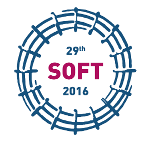Speaker
Mikio Saigusa
(College of Engineering)
Description
A neoclassical tearing mode (NTM) can be controlled by electron cyclotron current drive (ECCD). Up to now, ECCD with pulse modulated gyrotron operation at a duty of 50% have been done to drive current into only O-point of magnetic island of NTM. The fast directional switch have been developed for improving a stabilizing efficiency of NTM [1]. It makes the duty of ECCD system to 100% by switching beam direction for tracking the rotating magnetic island.
The wideband diplexer as a fast switching device of high power millimeter wave was proposed for a step tunable gyrotron [2]. The wideband diplexer was simulated numerically, and it was tested at the frequency of 170 GHz in low power [3]. However, the rf beam could not be switched by the frequency modulated diplexer with slotted metal half mirrors in high power tests [4]. There were two main reasons of this failure. One is large Ohmic loss of metal half mirrors [5]. The other is some variations in gyrotron frequency, so that the operation frequency band of diplexer was out of the gyrotron frequency band.
In this paper, the first results of the temperature controlled diplexer with sapphire half mirrors at a frequency band of 170 GHz are reported. The operation frequency of diplexer can be controlled by thermal expansion using a precision chiller, where the tunable frequency band is about 225 MHz. The switching operation is clearly observed in high power tests.
References [1] W. Kasparek, et al., Fusion Sci. Technol. 52, 281(2007). [2] M. Saigusa, et al., Proc. of 13th AMPERE Toulouse, 285 (2011). [3] M. Saigusa, et al., Fusion Eng. Des., Vol. 88, 964(2013). [4] M. Saigusa, et al., 20th Topical Conf., Vol.1580, 562(2014). [5] K. Atsumi, et al., Fusion Eng. Des., Vol. 8, 2405077 (2013).
Co-authors
Jyunya Mori
(College of Engineering, Ibaraki University, Hitachi, Ibaraki, Japan)
Kenji Sekiguchi
(College of Engineering, Ibaraki University, Hitachi, Ibaraki, Japan)
Koji Takahashi
(Naka Fusion Institute, Japan Atomic Energy Agency, Naka, Ibaraki 311-0193, Japan)
Mikio Saigusa
(College of Engineering, Ibaraki University, Hitachi, Ibaraki, Japan)
Ryosuke Ikeda
(Naka Fusion Institute, Japan Atomic Energy Agency, Naka, Ibaraki 311-0193, Japan)
Toshihiko Honzu
(College of Engineering, Ibaraki University, Hitachi, Ibaraki, Japan)
Yasuhisa Oda
(Naka Fusion Institute, Japan Atomic Energy Agency, Naka, Ibaraki 311-0193, Japan)

